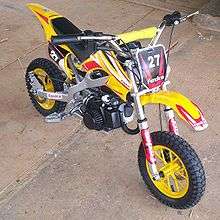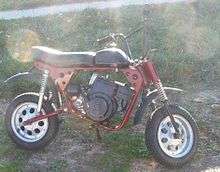Minibike


A minibike, sometimes called a minimoto or pocketbike, is a miniature motorcycle. Most minibikes use two-stroke engines and chain drive.
History

Like go-karts, the first minibikes were made by enthusiasts from spare parts found in their garages. They were first popularly used as "pit bikes", for drag racers to travel in the pits during races in the late 1950s. They were very useful for this purpose, as they could maneuver very well in the tight pit roads, fit in about the same space as a small bicycle in a trailer or pickup. As racers brought them home and used them around their neighborhoods, many children liked the idea of having a mini motorcycle and started building their own. The June 1967 Popular Mechanics magazine had an article with plans.[1] All you needed was an engine from a lawnmower and a neighbor with a welding torch.
- Commercial manufacture
A market for minibikes developed, and from the early 1960s many cottage and major industries developed to meet the demand. Most lawnmower shops began carrying a line of mini-bikes. Minibike companies include Arctic-Cat, Rupp, Taco, Heath, Gilson, and Fox, many of which also made other power toys such as go-karts, trikes and choppers. Traditional motorcycle manufacturers also began coming out with models like the Honda Z50A, inspired by aspects of minibikes. In America the peak of the minibike/go-kart era was from the late 1960s to the early 1970s. Many of the brands, foremost Rupp, have gained a cult-following of enthusiasts and owners.
- Early minibike power train
These early minibikes usually had a power train with a small four-stroke, horizontal crankshaft, flathead engine. The transmission usually was of a crank-mounted centrifugal clutch and chain drive to a rear sprocket. As the minibike and the mini-powersports field grew, Comet introduced a continuously variable transmission, much like a snowmobile's, called the Torque-a-Verter, which automatically adjusts gear ratios, resulting in better top speed and acceleration.
Types
Today minibikes have evolved into several specialized types.
- Pocketbike/minimoto
These look like sport bikes and are used in pocketbike racing on kart racing tracks. The usual height is less than 50 cm (20 in), and up to 1 m (3 ft 3 in) length. Power usually comes from a 39–50 cc (2.4–3.1 cu in) two-stroke engine with a maximum of 4.5–6 horsepower (3.4–4.5 kW). Maximum speed varies between 30 to 64 km/h (19 to 40 mph). Pocketbikes are also made in both four-stroke gasoline and electric versions. The four-stroke models are usually 110cc automatic or manual engines, and are referred to as Super Pocket Bikes. Common Super Pocket Bike models include the X7, X15, X18, X19, and X22. The popularity of these types of minibikes grew due to the influx of cheap pocket bikes imported from China.
- Pitbikes
Pit bikes are true to the original concept of a small scooter used to quickly move around the pit areas of motor racing tracks and events. Modern versions look like motocross motorcycles and are also used in some motocross competitions. Recently the sport of pitbike racing (racing pit bikes on motocross and supercross tracks) has taken off. There are numerous series in the United States and there are also full-fledged pitbike pros. The Las Vegas Mini Supercross is the biggest pitbike event of the year.
The sport of mini-motard consists of pitbikes racing with slick tires on go-cart tracks, much like super-motard or super-moto. The bikes are prepared for racing with precautions such as catch tanks to collect fluid spills on the track, causing skidding hazards.
- Mini choppers
Mini choppers are mini bikes that look like choppers, but still have the general look of a pocket or mini bike.
- Midi motos / Super pocket bikes
Midi motos, also called super pocket bikes,[2] are similar to pocket bikes, but slightly larger. They are still smaller than the street bikes they mimic, but the seat height is about a foot to two feet higher than a mini moto's seat height. They started off with 47cc 2 stroke engines (capable of around 48–64 km/h/30-40 mph) in the midi motos and then included 110cc 4 stroke engines (capable of around 86–105 km/h/55-65 mph). Most midi bikes are made in China and usually equipped with a Honda engine or copy of a Honda engine.
- Quad bikes
- Mini bikes that look like all terrain vehicles or quad bikes, which are four-wheeled off-road motorcycles.
Legal status
USA
DOT laws vary by state, but for the most part minibikes are illegal for use on public roadways because most do not carry the necessary equipment (and often size requirements) to be street legal. In many states the seat of a motorcycle must be at least 25 inches (64 cm) off the ground, which is often a limiting factor in registration. Usage on public roadways may result a number of offenses,[3] including but not limited to: no indicator lights, no rearview mirror, no horn or signaling device, no headlight, too-small muffler (noise pollution), improper lane change (no blinkers), or reckless driving.
Some of the larger "super" pocket bikes, most commonly the X15 (FS549), X18 (FS559), X19 (FS569), and X22 could meet all the requirements. However, they were imported and sold as "off road use purposes only". In some states, they could be registered for legal street use by converting an off-road purposes only bike into a road-worthy model. These bikes had headlights, turn signals, tail/brake lights, a horn, and speedometer, and could also do the speed limit in most scenarios (typically 4 stroke bikes with manual 4 speed transmissions can reach speeds of 55 mph). In many states all one needs to do is add a rearview mirror and a license plate bracket, but it is best to check with local DMV authorities for exact requirements. In some cases, if the bike requires minor modification to meet requirements, one may be able to register it as a "unique/home-built."
Like real full-size motorcycles, the rider of a modified super pocket bike must carry insurance, have a current inspection, and wear a helmet if local laws require it. Depending on if the state classes a pocketbike as a "moped" or full "motorcycle", the rider may or may not need a special motorcycle license. If not, a regular driver's license may suffice.
.
Canada
In Canada mini motorcycles, commonly referred to as “pocket bikes” or "mini choppers,” do not meet federal safety standards for use on public roads. These vehicles do not meet minimum height specifications for headlamps, tail lamps, stop lamps, and turn signals. They are also difficult for other motorists to see.
Transport Canada classifies mini motorcycles as restricted use motorcycles that are permitted to be imported as competition vehicles for closed-course racing only.[4]
In Ontario, pocket bikes may not be operated on public roads, sidewalks, or parks. It is recommended riders be twelve years of age or older to ride pocket bikes. The minimum fine for being caught while riding a Pocket Bike on anything but private property is $5000, which does not include other fines such as reckless driving which an officer may choose to charge. Although many people unknowingly disobey the law by riding these bikes in side walks and parks, police officers do not fine riders without a complaint from other people. Pocket bikes may not be driven on highways under any circumstances.
In Alberta, pocket bikes are considered miniature vehicles, which may only be operated on private property. Miniature vehicles include: personal transporters, pocket bikes, go-carts, electric scooters, and golf carts.[5][6]
In British Columbia, a $900 fine may be applied along with seizure of the vehicle. It is not recommended that children under 6 years of age be permitted to ride.
United Kingdom
In the UK, it is illegal for minibikes to be ridden on public roads or off-road on public land. The only places these types of vehicle may be ridden are purpose-built race tracks and privately owned land with the owner's permission (and where they do not cause harassment, alarm or distress). All of these minibikes are regarded as "motor vehicles" as defined by section 185 of the Road Traffic Act 1988 and so to be ridden on the public road, a motor vehicle must comply with all aspects of road traffic law and meet the mandatory European construction requirements by having a "Certificate of Conformity" indicating that they have European Community Whole Vehicle Type Approval (ECWVTA).[7]
Minibikes are not manufactured to meet these requirements, and would need to be modified significantly to do so. Reported instances of this occurring are incredibly rare, meaning that it is very unlikely that minibikes can actually be registered for road use. However, where a minibike or other vehicle does not have ECWVTA, it might conceivably pass a Motorcycle Single Vehicle Approval (MSVA) inspection which would result in a Ministerial Certificate of Approval, permitting it to be road-registered.
In addition to the Vehicle Type Approval, to be ridden on the road the minibike must be registered with the Driver and Vehicle Licensing Agency, display a valid road tax disc (vehicle excise duty), and the driver or rider must be aged 17 or over (or 16 if the vehicle meets the definition of a moped), have an appropriate driving license, and insurance. The only exceptions relate to electrically-assisted pedal cycles and mobility aids for disabled people. In the UK there are in most areas mini bike tracks for the public.
During August 2006 the UK Government ran a campaign to highlight the dangers of minibike misuse on roads and their anti-social use. A guidance document was produced to provide police and other agencies with practical information to deal with the issues and prevent misuse. The guidance outlined the legal status of minibikes and included information on enforcement measures and the provision of legal sites.[8]
Later the death of Abbi Perrin from Louth brought the dangers back into public view.[9]
Police may seize and destroy the vehicle and prosecute the rider when caught riding on public roads.[10]
Safety
Minibikes are not toys, although often treated as such. Even the cheapest 38 cc US-made bikes (often sold for as little as $150) are capable of speeds of at least 25 mph (40 km/h). The 49 cc pocket bikes can reach speeds of 30 to 45 mph (48 to 72 km/h), and the 110–125 cc four-stroke bikes are capable of 60-80 mph. Gasoline-powered bikes are substantially faster and require more skill than off-the-shelf electric bikes, which typically can not exceed 10 to 15 mph (16 to 24 km/h).[11]
The number of injuries caused by pocket bikes each year is unknown. The Consumer Product Safety Commission (CPSC) estimates that 2,345 injured riders of pocket bikes and larger minibikes were treated in emergency rooms in 2003. There have also been numerous deaths in The USA and Canada.[12]
See also
| Wikimedia Commons has media related to Minibikes. |
- Tote Gote
- Pocketbike racing
- Honda Z series - known in the UK as the Monkey bike.
- Mini chopper
- MotoVox
References
- ↑ "Build Yourself A Minibike" June 1967, p160, Popular Mechanics
- ↑ "SUPER POCKET BIKES". TEMPLE CITY, California, USA: Mini Pocket Rockets. Retrieved 29 May 2014.
- ↑ From Popular Mechanics, at http://www.popularmechanics.com/outdoors/adventures/1278186.html?page=3
- ↑ "Pocket bikes (mini motorcycles); Mini motorcycles cannot be operated on roads in B.C.". Insurance Corporation of British Columbia.
- ↑ Owning and Operating a Small Vehiclein Alberta
- ↑ New and Alternative Vehicles
- ↑ “Vehicle Type Approval”
- ↑ “The Home Office press release”
- ↑ BBC News "Man jailed over mini-moto death"
- ↑ Police get tough on minimoto bikes - Worcester News
- ↑ "Pocket Bike Hazards". Roberts Law Firm.
- ↑ Wright, Jeanne, "Small pocket bikes, big dangers", Los Angeles Times
External links
- Minimoto at DMOZ
- Mini bike at DMOZ
- Royal Society for the Prevention of Accidents – Mini Motorbike Safety Factsheet (PDF)